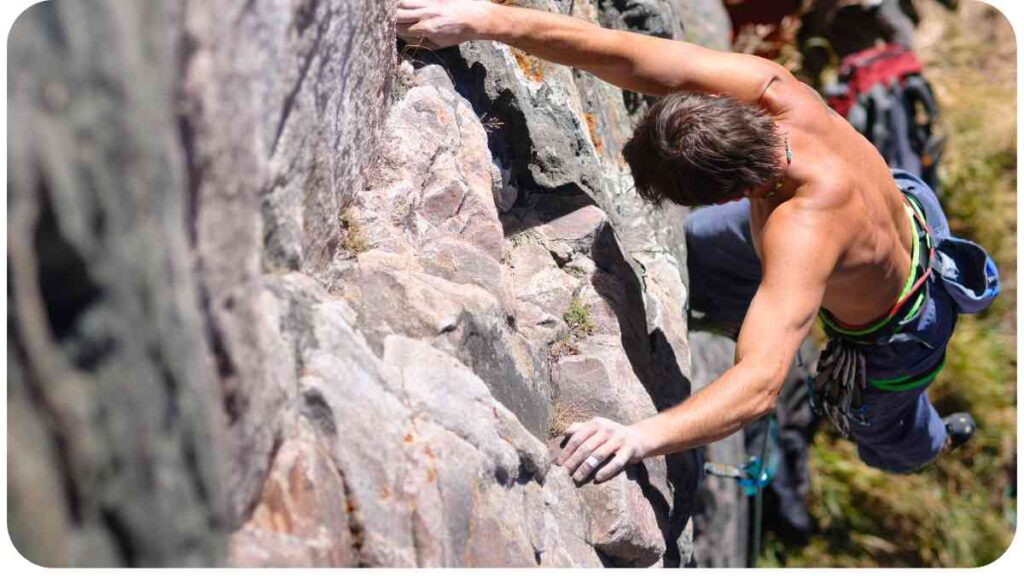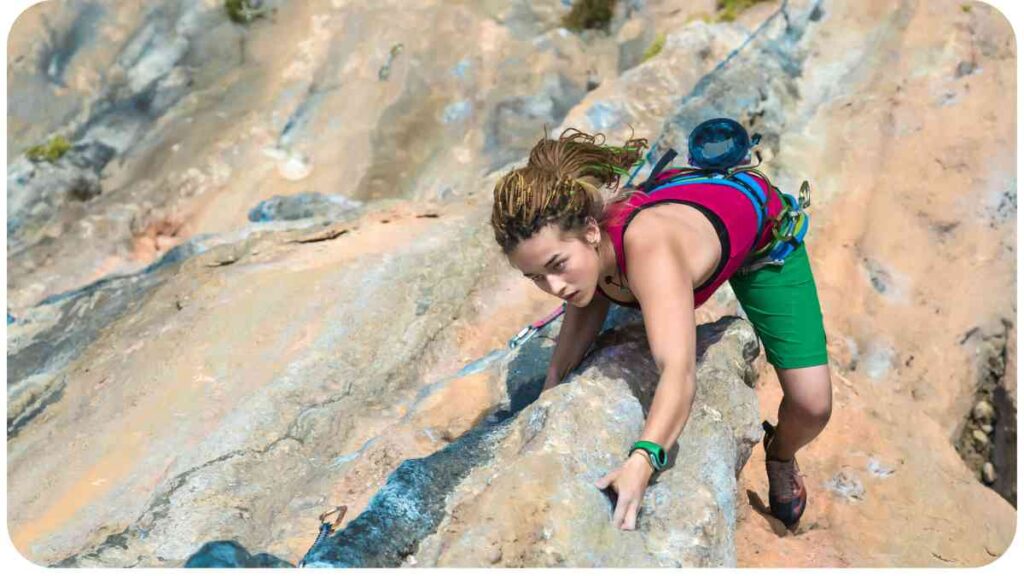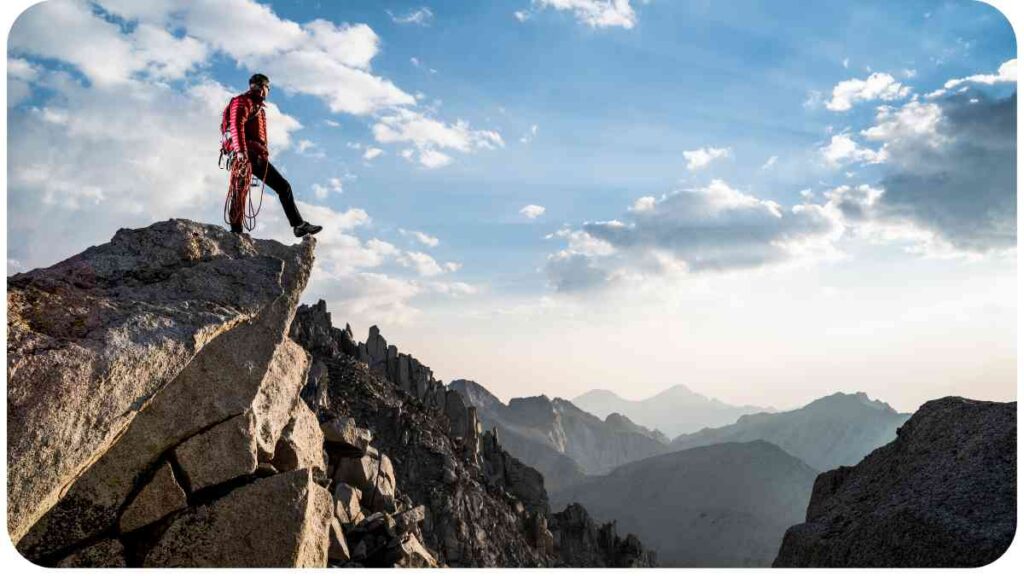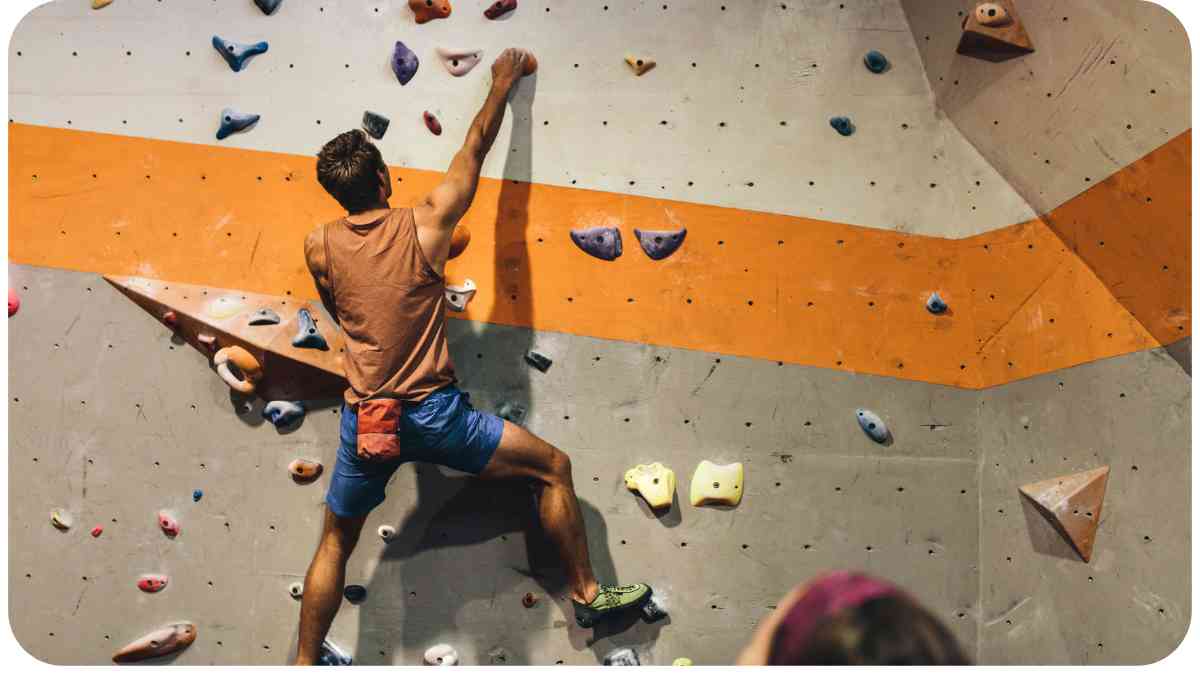Welcome to the thrilling world of lead climbing! Whether you’re a seasoned climber or just starting, understanding the nuances of strength and endurance workouts is crucial for success.
In this comprehensive guide, we’ll delve into the intricacies of lead climbing, explore the science behind climbing muscles, and provide actionable advice to enhance your climbing performance.
| Takeaway |
|---|
| Lead climbing is a strategic dance between climber and rock, requiring a blend of strength, endurance, and mental resilience. |
| Understanding the science behind climbing muscles is crucial, with specific focus on forearms, core, legs, and back. |
| Building a solid foundation involves targeted strength training exercises for core, finger and grip strength, as well as leg stability. |
| Endurance workouts, including aerobic conditioning and high-intensity interval training (HIIT), are essential for sustained climbing performance. |
| Periodization, tailored to climbing phases, ensures peak performance and prevents burnout. |
| Mental toughness is as important as physical strength, involving visualization, positive affirmations, and breathing techniques. |
| Nutrition plays a pivotal role in climbing, with a focus on proteins, carbohydrates, fats, and effective hydration. |
| Selecting the right gear, including climbing shoes, harness, and safety equipment, significantly impacts climbing performance and safety. |
| Injury prevention and recovery techniques, along with monitoring progress through goal-setting, are integral to long-term climbing success. |
| Learning from professionals and avoiding common mistakes, such as overtraining, contributes to a well-rounded and sustainable climbing journey. |
Understanding Lead Climbing

2.1 The Basics of Lead Climbing
Lead climbing isn’t just about reaching the top; it’s a strategic dance between climber and rock. We’ll cover the fundamentals to ensure you grasp the essentials.
Elevate your lead climbing experience with a focus on safety essentials. Learn about must-have gear and best practices to ensure a secure ascent. Discover the importance of safety gear and climb confidently.
Table 1: Lead Climbing Basics
| Term | Definition |
| Lead Climbing | Climbing where the climber leads, placing gear |
| Protection | Equipment to arrest falls |
| Belaying | Safely managing the climbing rope |
| Dynamic Movement | Fluid and controlled climbing style |
2.2 Importance of Strength and Endurance
Strength and endurance are your allies in conquering challenging routes. Let’s explore why these attributes are vital.
Table 2: Strength vs. Endurance
| Attribute | Strength | Endurance |
| Definition | Maximum force exerted in a single effort | Sustaining effort over an extended period |
| Importance | Overcoming crux moves and difficult holds | Climbing for extended periods without fatigue |
The Science Behind Climbing Muscles
3.1 Muscle Groups Involved
Understanding the muscles at play is crucial. We’ll highlight the key muscle groups engaged in lead climbing.
Take your lead climbing skills to new heights with these advanced techniques. Explore pro tips that go beyond the basics, providing insights into advanced techniques for a more challenging and rewarding climb.
Table 3: Muscles Used in Climbing
| Muscle Group | Primary Role | Exercises |
| Forearms | Grip strength | Hangboard exercises, forearm curls |
| Core | Stability and body control | Planks, leg raises, wood chops |
| Legs | Weight-bearing support | Squats, lunges, calf raises |
| Back | Pulling and posture | Pull-ups, lat pulldowns, rows |
3.2 Adaptations for Lead Climbing
Climbing induces specific muscle adaptations. Let’s explore how your body adjusts to the demands of lead climbing.
Table 4: Muscle Adaptations in Climbers
| Adaptation | Description |
| Hypertrophy | Muscle growth due to resistance training |
| Tendon Strength | Enhanced strength of tendons, crucial for gripping holds |
| Endurance Capacity | Improved ability to sustain efforts for prolonged climbing |
Building a Solid Foundation
4.1 Strength Training Exercises
4.1.1 Core Strengthening
Building a robust core is the cornerstone of climbing strength. Incorporate these exercises into your routine.
Table 5: Core Strengthening Exercises
| Exercise | Technique | Frequency |
| Planks | Maintain a straight body position | 3 sets, 30 seconds to 1 minute each |
| Leg Raises | Lift legs while lying on your back | 3 sets of 15 reps |
| Wood Chops | Rotate torso while holding a weight | 3 sets of 12 reps each side |
4.1.2 Finger and Grip Strength
Your hands are your primary connection to the rock. Strengthening your fingers and grip is essential for tackling crux moves and precarious holds.
Dive into the competitive world of lead climbing with a comprehensive guide. Understand the rules, strategies, and preparation needed for success in lead climbing competitions. Gear up for the thrill of competition!
Table 6: Finger and Grip Strength Exercises
| Exercise | Technique | Frequency |
| Hangboard Training | Hang from fingerboard holds, varying grips | 2-3 times a week, 5-10 seconds each |
| Finger Rolls | Roll a weight up and down with fingers | 3 sets of 12 reps |
| Deadhangs | Hang from a bar with straight arms | 3 sets, 10-15 seconds each |
4.1.3 Leg Workouts for Stability
While climbing heavily involves upper body strength, neglecting your legs is a common mistake. Sturdy legs provide a stable foundation for challenging ascents.
Table 7: Leg Workouts for Climbing Stability
| Exercise | Technique | Frequency |
| Squats | Lower into a sitting position, then stand up | 3 sets of 10-12 reps |
| Lunges | Step forward and lower your body | 3 sets of 12 reps each leg |
| Calf Raises | Rise onto your toes and lower back down | 3 sets of 15 reps |
Endurance Workouts
4.2 Endurance Workouts
Now that we’ve laid the foundation with strength training, let’s shift our focus to endurance workouts, crucial for sustaining your climbing performance.
Stay ahead in the world of lead climbing with insights into the latest trends and innovations. Explore how technology and techniques are reshaping the sport in lead climbing. Embrace the evolution of climbing!
4.2.1 Aerobic Conditioning
Climbing is not just about bursts of power; it requires prolonged stamina. Incorporate aerobic conditioning to improve your cardiovascular fitness.
Table 8: Aerobic Conditioning Exercises
| Exercise | Technique | Duration |
| Trail Running | Run on trails with varying terrain | 30 minutes, 2-3 times a week |
| Stationary Bike | Maintain a steady pace on a stationary bike | 20-30 minutes, 3 times a week |
| Jump Rope | Continuous jumping with short breaks | 15 minutes, 3 times a week |
4.2.2 High-Intensity Interval Training (HIIT)
HIIT is a fantastic way to simulate the intensity fluctuations of lead climbing. It combines short bursts of intense effort with brief rest periods.
Table 9: HIIT for Climbing Endurance
| Exercise | Technique | Interval Duration |
| Climbing Intervals | Alternating between high and moderate-intensity climbs | 30 seconds on, 30 seconds off |
| Burpees | Intense full-body exercise | 20 seconds on, 10 seconds off |
| Mountain Climbers | Dynamic exercise targeting core and legs | 40 seconds on, 20 seconds off |
Periodization for Climbing Success

5.1 Understanding Periodization
Periodization involves breaking down your training into distinct phases, each with specific goals. This approach prevents burnout, promotes recovery, and ensures peak performance during crucial times.
Navigate the nuances between outdoor and indoor lead climbing with this comprehensive guide. Understand the differences, challenges, and joys of both realms in lead climbing. Choose your climb, whether on natural rocks or gym walls
Table 10: Periodization Phases
| Phase | Focus | Duration |
| Base Phase | Build foundational strength and endurance | 4-6 weeks |
| Strength Phase | Intensify strength training for specific gains | 4-6 weeks |
| Power Phase | Transition to power-focused exercises | 3-4 weeks |
| Peak Phase | Fine-tune skills and taper for optimal performance | 2-3 weeks |
5.2 Applying Periodization to Climbing
Let’s tailor the concept of periodization to the climbing realm, ensuring you peak at the right moment for your climbing goals.
Table 11: Climbing-Specific Periodization
| Phase | Climbing Emphasis | Key Workouts |
| Base Phase | Endurance routes, focus on technique | Long, moderate climbs; skill-based sessions |
| Strength Phase | Intensive strength training, bouldering | Hangboard workouts, bouldering sessions |
| Power Phase | Dynamic movements, campus board training | Dynamic climbing drills, campus board exercises |
| Peak Phase | Redpoint attempts, refine specific skills | Short, intense climbs; mimic actual climbing conditions |
Mental Toughness and Climbing
6.1 The Psychological Aspect
Climbing is not just a physical challenge; it’s a mental game. Developing mental toughness is as crucial as building physical strength.
Table 12: Mental Toughness Techniques
| Technique | Description | Application |
| Visualization | Imagine successful climbs before attempting | Visualize routes, rehearse movements mentally |
| Positive Affirmations | Replace self-doubt with positive statements | Affirmations before and during climbs |
| Breathing Techniques | Control anxiety and maintain focus | Deep breaths during challenging sections |
6.2 Developing Mental Resilience
Climbing often presents unexpected challenges. Building mental resilience ensures you navigate setbacks and stay focused on your goals.
Table 13: Building Mental Resilience
| Strategy | Approach | Application |
| Embracing Failure | View failures as learning opportunities | Analyze unsuccessful climbs, adjust and improve |
| Goal Setting | Break down goals into manageable steps | Set realistic milestones, celebrate achievements |
| Mindfulness | Stay present and focused in the moment | Practice mindfulness during climbs and training |
Nutrition for Peak Climbing Performance

7.1 Fueling Your Body
Climbing demands energy, and your nutrition plays a pivotal role in supplying the necessary fuel. Let’s explore the key components of a climber’s diet.
Table 14: Essential Climbing Nutrients
| Nutrient | Importance | Food Sources |
| Protein | Muscle repair and growth | Chicken, fish, beans, lentils |
| Carbohydrates | Primary energy source | Whole grains, fruits, vegetables |
| Fats | Long-lasting energy | Nuts, seeds, avocados, olive oil |
| Hydration | Prevent dehydration and maintain performance | Water, electrolyte-rich drinks |
7.2 Hydration Strategies
Staying hydrated is non-negotiable for climbers. Dehydration can impact performance and increase the risk of injuries. Let’s discuss effective hydration strategies.
Table 15: Hydration Tips for Climbers
| Tip | Description | Application |
| Pre-hydration | Start your climbing day well-hydrated | Drink water in the morning and throughout the day |
| During Climbing | Regular sips, especially during breaks | Carry a water bottle and sip during rests |
| Rehydration | Replenish fluids post-climbing | Drink water with electrolytes to aid recovery |
Gear and Equipment Essentials
8.1 Climbing Shoes
The right climbing shoes can significantly impact your performance. Let’s explore the essential factors to consider when choosing climbing footwear.
Table 16: Choosing the Right Climbing Shoes
| Factor | Importance | Considerations |
| Fit | Snug but not painful; consider type of climbing | Try on multiple pairs, consider your climbing style |
| Type | Different shoes for bouldering and lead climbing | Choose shoes based on your primary climbing activity |
| Closure System | Laces, Velcro, or slip-on | Personal preference and ease of use |
8.2 Harness and Safety Gear
Safety should be your top priority. Let’s discuss the key elements of a climbing harness and other safety gear.
Table 17: Climbing Safety Gear
| Gear | Purpose | Considerations |
| Harness | Distributes weight and secures climber | Comfort, adjustability, and type of climbing |
| Helmet | Protects head from falling objects | Proper fit, durability, and ventilation |
| Belay Device | Controls rope during belaying | Compatibility with your rope and ease of use |
Injury Prevention and Recovery
9.1 Common Climbing Injuries
Understanding potential climbing injuries is vital for prevention. Let’s discuss common issues climbers may encounter and how to avoid them.
Table 18: Common Climbing Injuries and Prevention
| Injury | Prevention Strategies |
| Tendon Strain | Gradual increase in training intensity, proper warm-up |
| Pulley Injuries | Finger strength training, avoiding over-gripping |
| Elbow Tendonitis | Adequate rest, eccentric exercises for forearm strength |
| Shoulder Impingement | Proper warm-up, shoulder-strengthening exercises |
| Stress Fractures | Balanced training, sufficient calcium and vitamin D |
9.2 Recovery Techniques
Recovery is as crucial as training. Let’s explore effective recovery techniques to keep you climbing at your best.
Table 19: Climber’s Recovery Toolbox
| Technique | Description | Application |
| Active Recovery | Light exercise to promote blood flow and reduce stiffness | Post-climbing cooldown, active rest days |
| Foam Rolling | Self-myofascial release to alleviate muscle tightness | Target major muscle groups for 10-15 minutes |
| Contrast Baths | Alternating between hot and cold water immersion | Reduce inflammation and promote circulation |
Training Progression and Tracking
10.1 Setting Goals
Setting clear and achievable goals is essential for continuous improvement. Let’s discuss effective goal-setting strategies for climbers.
Table 20: SMART Climbing Goals
| Element | Description | Example |
| Specific | Clearly defined objective | “Complete a 5.11 lead climb within three months” |
| Measurable | Quantifiable criteria for success | “Increase hangboard duration by 15 seconds” |
| Achievable | Realistic and attainable | “Train three times a week for the next two months” |
| Relevant | Aligns with your climbing aspirations | “Improve bouldering skills to tackle more challenging problems” |
| Time-Bound | Has a defined timeline | “Reach the summit of Mount XYZ within the next year” |
10.2 Tracking Progress
Regularly monitoring your progress is crucial for staying on track and making adjustments as needed. Let’s explore effective ways to track your climbing journey.
Table 21: Tracking Progress Metrics
| Metric | Tracking Method | Frequency |
| Climbing Grades | Log completed climbs with difficulty ratings | After each climbing session |
| Strength Levels | Record hangboard and strength training achievements | Weekly or bi-weekly check-ins |
| Endurance Stamina | Track climbing duration and rest intervals | Every climbing session |
| Goal Milestones | Document achieved goals and set new ones | Monthly reflections and adjustments |
Tips from the Pros
11.1 Professional Climbers’ Insights
Learning from the best in the field can significantly elevate your climbing journey. Let’s delve into insights shared by professional climbers.
Table 22: Pro Climber Tips
| Pro Tip | Climber | Key Takeaway |
| “Consistency is key. Climbing regularly, even for shorter durations, yields better results than sporadic intense sessions.” | Alex Honnold | Building a consistent climbing routine is crucial for improvement. |
| “Embrace failure as part of the journey. Every fall is an opportunity to learn and grow as a climber.” | Ashima Shiraishi | Resilience is key; setbacks are stepping stones to success. |
| “Train your weaknesses. Identifying and working on your weaknesses is a direct path to overall improvement.” | Adam Ondra | Targeted training addresses specific challenges and enhances overall performance. |
11.2 Training Regimens of Successful Climbers
Let’s explore the training regimens of some renowned climbers and understand how they structure their workouts.
Table 23: Training Regimens of Successful Climbers
| Climber | Training Focus | Key Workouts |
| Tommy Caldwell | Endurance and grip strength | Long endurance climbs, fingerboard training |
| Shauna Coxsey | Power and agility | Campus board exercises, bouldering sessions |
| Chris Sharma | Flexibility and dynamic movements | Yoga for climbers, dynamic bouldering drills |
Common Mistakes to Avoid
12.1 Overtraining Pitfalls
While training is essential, overtraining can lead to burnout and injuries. Let’s discuss common overtraining mistakes and how to avoid them.
Table 24: Overtraining Pitfalls and Solutions
| Pitfall | Solution |
| Neglecting Rest Days | Incorporate active rest days for recovery |
| Ignoring Warning Signs | Listen to your body; adjust intensity if needed |
| Lack of Cross-Training | Include varied exercises to prevent monotony |
12.2 Ignoring Rest Days
Rest days are not a sign of weakness but a crucial part of a well-rounded training plan. Let’s explore the importance of rest and recovery.
Table 25: Rest and Recovery Tips
| Tip | Description | Application |
| Adequate Sleep | Ensure 7-9 hours of quality sleep | Vital for muscle repair and overall well-being |
| Active Recovery | Light exercises to promote blood flow | Gentle stretching, walking, or yoga on rest days |
| Mental Rest | Take breaks from climbing mentally challenging routes | Enjoy easier climbs or recreational activities |
Real-Life Climbing Stories
13.1 Personal Successes
Hearing about real triumphs can be inspiring and provide valuable insights. Let’s explore some personal climbing success stories.
Table 26: Climbing Success Stories
| Climber | Success Story |
| Emily’s First Lead Climb | Overcame fear of falling, completed a challenging lead climb for the first time. |
| Jake’s Bouldering Breakthrough | Mastered a bouldering problem after weeks of attempts, showcasing persistence and skill improvement. |
| Sarah’s Summit Victory | Reached the summit of a challenging peak, highlighting the rewards of long-term training and dedication. |
13.2 Learning from Failures
Climbing is a journey filled with challenges. Let’s explore stories of climbers overcoming setbacks and the valuable lessons learned.
Table 27: Climbing Lessons from Setbacks
| Climber | Setback Story and Lesson Learned |
| Alex’s Finger Injury | Sustained a finger injury due to overtraining, emphasizing the importance of rest and listening to the body. |
| Mia’s Route Failure | Failed multiple attempts on a route, highlighting the need for perseverance and learning from failures. |
| Chris’s Mental Block | Overcame a mental block by focusing on mindfulness and visualization techniques, showcasing the power of mental resilience. |
Q&A Session
14.1 Answering Your Climbing Queries
Let’s address some common questions climbers often have, providing insights and advice.
Table 28: Climbing Q&A
| Question | Answer |
| “How can I improve my grip strength?” | Incorporate fingerboard exercises and deadhangs into your routine. |
| “What’s the best way to prevent elbow tendonitis?” | Gradually increase training intensity, include eccentric exercises, and prioritize rest. |
| “How often should I change my climbing shoes?” | Change shoes when they lose their snug fit or show signs of significant wear. |
Conclusion
In this comprehensive guide, we’ve covered various aspects of lead climbing, from the basics to advanced training techniques. Remember, climbing is not just a physical endeavor; it’s a mental challenge and a journey of self-discovery.
Use the insights, tips, and real-life stories shared here to inform your training, set achievable goals, and enjoy the incredible adventure that is lead climbing.
As you embark on your climbing journey, always prioritize safety, listen to your body, and stay curious. Climbing is not only about reaching the summit but about the joy of the climb itself. Whether you’re a beginner or an experienced climber, may each ascent bring you closer to your goals and deepen your love for the sport.
Further Reading
- Lattice Training: Training Series – Endurance: Explore a comprehensive training series focused on improving climbing endurance. This resource delves into specific techniques and exercises to enhance your endurance on the rock.
- Training for Climbing: Slowing the Pump Clock to Improve Climbing Endurance: Learn strategies for slowing down the pump clock and enhancing climbing endurance. The article provides practical tips and insights to optimize your endurance training.
- Garage Strength: Strength Training for Climbing: Delve into the world of strength training tailored for climbing. This resource offers valuable information on exercises and techniques to build the strength necessary for challenging climbs.
FAQs
How can I improve my grip strength?
Incorporate fingerboard exercises and deadhangs into your routine to specifically target and enhance your grip strength.
What’s the best way to prevent elbow tendonitis?
Gradually increase training intensity, include eccentric exercises for forearm strength, and prioritize sufficient rest to help prevent elbow tendonitis.
How often should I change my climbing shoes?
Change your climbing shoes when they lose their snug fit or show signs of significant wear to ensure optimal performance and safety.
What are the key components of a climber’s diet?
A climber’s diet should include essential nutrients such as protein for muscle repair, carbohydrates for energy, fats for long-lasting energy, and proper hydration to prevent dehydration.
How do I develop mental resilience for climbing?
Develop mental resilience by embracing failure as a learning opportunity, setting realistic goals, and practicing mindfulness to stay present and focused during climbs.

Welcome to my blog! I’m Hellen James, and I’m incredibly passionate about rock climbing, bouldering, ice climbing, and mountaineering. Join me as I embark on thrilling adventures, conquer vertical challenges, and share my experiences and insights with fellow outdoor enthusiasts.


